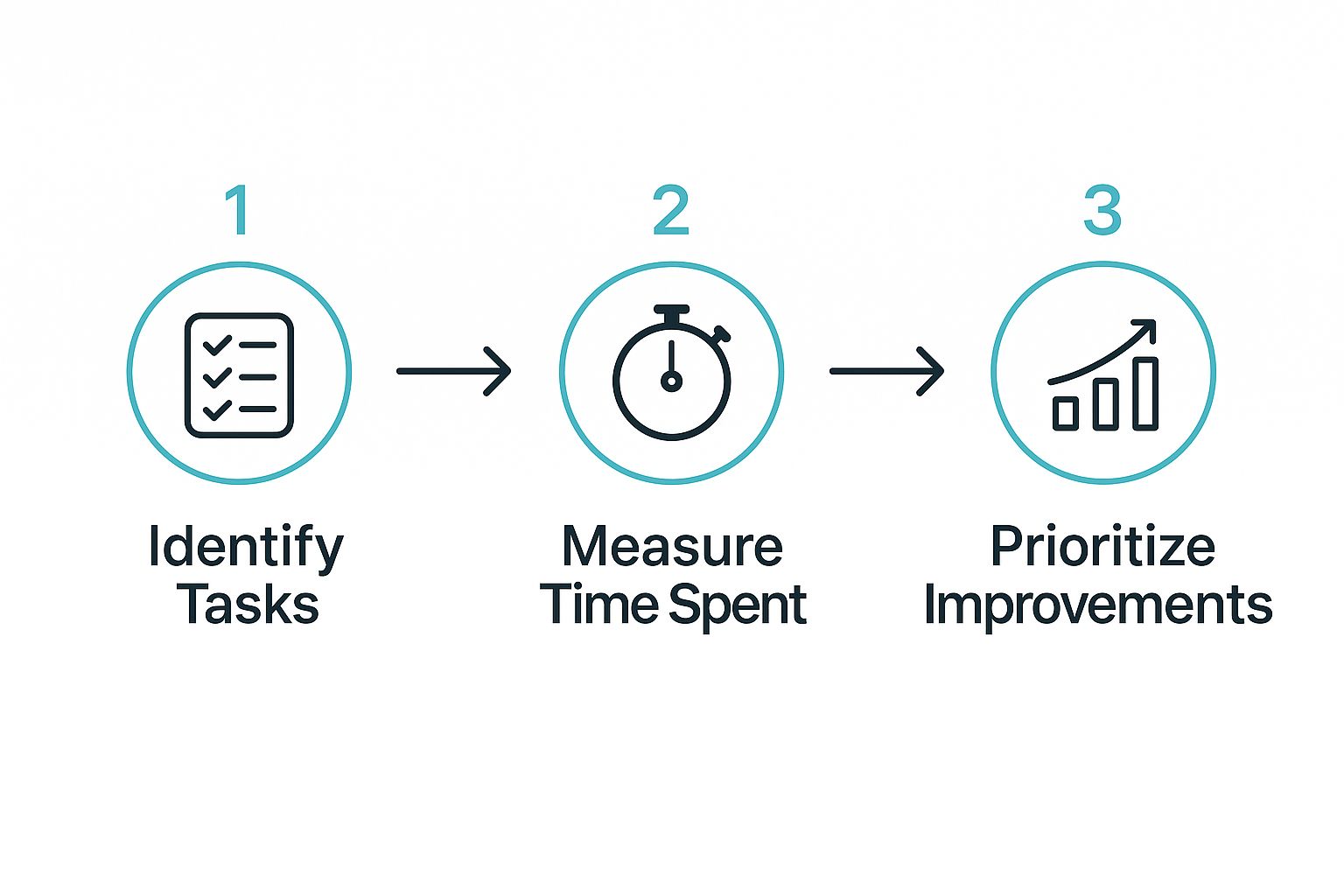Making your team better isn't about making people work harder. It's about working smarter. The trick is to make small changes that stop confusion. This helps everyone work together and pull in the same direction. It is about turning "busy work" into work that really matters.
11 Ways to Help Your Team Work Better
Have you ever seen a team that just works well together? They get things done without stress or problems. This is not by luck. They have good habits and a smart system that helps everyone do their best work as a team.
Helping your team work better is not about watching every little thing they do. It's about removing the things that slow them down. Think of it like fixing up a car. A few small changes can make it run much faster and get you where you need to go.
Start with Clear Rules and Talk to Each Other
Most of the time, confusion is what slows people down. When people do not know what they should be doing or why it is important, they waste time. Some studies show people can waste most of their day on "work about work." This is time spent looking for papers, waiting for a "yes," or just trying to figure out what to do next. That is a lot of lost time.
The good news is you can get that time back. The ideas we will talk about are easy to use right now. It is all about making work feel less messy and more important.
"Being good at your job is not about being busy. It is about doing the right things. When a team knows what to do and trusts each other, they get great things done."
Here is a quick look at the main ideas to help your team work better together, starting now.
Quick Ways to Help Your Team Work Better
Here are the main ideas for helping your team work better, starting now.
| What to Focus On | Your First Step |
|---|---|
| Meetings | Make a clear plan for every meeting and share it before you start. |
| Goals | Make sure everyone on the team can explain how their job helps the main goal. |
| Trust | Make a safe space where team members can ask for help and not feel bad. |
| Tools | Look at your computer programs. Do they help or make it harder to work together? |
| Talking | Set up one main place where all the news about a project is kept. |
These are the basics. By focusing on these things, you build a team that is not just fast, but also happy, excited, and strong. Let's look at the special tricks you can use.
Have Meetings That Don't Waste Time
Let's be real, most meetings are a big waste of time. They can feel like a room full of people where no one knows why they are there, and nothing gets done. The secret is not just to have better meetings. It is to not have them at all if you can.
Before you send a meeting invite, ask yourself this big question: "Can this be an email or a quick chat message instead?" You would be surprised how many times the answer is yes.
I worked with a team that stopped having their long weekly meeting. Instead, they used a shared to-do list online. They changed a one-hour meeting into a quick 15-minute chat just to talk about problems. What happened? They got hours of work time back every single week.
The 30-Minute Max Rule
People can only pay attention for a short time. After about 30 minutes, they start to get distracted. Their minds wander, they look at their phones, and work stops. That is why I love the 30-minute max rule.
If a topic seems like it needs more than 30 minutes, it means the plan is too big. Break it into smaller, more focused talks.
This makes you stick to your plan and get to the point. It also tells your team that their time is important. Giving them hours back in their day is one of the fastest ways to make them happier and work better.


As the picture shows, finding out where you are losing time is the first big step. From there, you can make smart changes that really work.
Only Ask People Who Really Need to Be There
We have all been in a meeting thinking, "Why am I here?" It is a waste of time and money that you can easily stop. One of the best tricks for better meetings is to invite fewer people.
For every person you think about asking, ask yourself two simple questions:
- Do we need their ideas to make a choice?
- Do they know something important that no one else knows?
If the answer to both is a clear "no," do not invite them. You can always send them a quick note about what happened later. This keeps the talk short and makes sure only the most important people are there.
A small, focused group will almost always solve a problem faster than a big, distracted one. The goal is not to have everyone there; it is to have the right people there.
Give Every Meeting One Clear Job
Every meeting needs one job to do. A single, clear reason for being there. Are you there to make a final choice? Think of new ideas? Solve one hard problem? You have to decide this before you invite anyone.
Put that one job at the top of the meeting plan and the invite. When everyone knows exactly why they are there, you stop the long talks that go nowhere.
A meeting with one clear job has a clear end. For a deeper look at this, you can learn more in our guide on how to run effective meetings. Once that job is done, the meeting is over, and your team can get back to their real work.
Give Everyone a Clear Job and Goal
Imagine playing soccer but no one knows their position. It would be a mess. But many offices work this way. People are not sure what their exact jobs are.
When jobs are not clear, people do the same work by mistake. Or, a big part of a project gets missed because everyone thought someone else was doing it. This is not just slow; it makes people upset and wastes a lot of effort.


This is a big deal. Studies show that many people spend up to 60% of their day on "work about work." This is the time they spend just trying to figure out who is doing what, finding papers, and asking for updates. By just making jobs and goals clear, you can give your team a huge amount of time back for real work.
Make a "Who Does What" List
One of the best tools I have seen is a simple, one-page paper that says exactly who does what. A small tech company I worked with called it their "Who Does What?" list. The change was huge and happened right away.
No one was confused about who to ask about a computer bug or a money question. The list became the place to look, which stopped the guesswork and made talking much faster.
Making one is easy:
- List every team member's name.
- Next to each name, write their top 3-5 main jobs. Keep it simple and clear. For example, instead of "Takes care of customers," write "Is the main person to talk to for our top 10 biggest customers."
- Make this paper easy for everyone to find. Put it in your team's chat group, on your project board, or in a shared folder.
This simple paper stops people from getting in each other's way. It helps them solve problems faster. For more ideas on how to set up your team's work, you can look at our business checklist.
When people know exactly what their job is and see how it helps the team win, they feel proud of their work. They stop waiting to be told what to do and start finding ways to help the team move forward.
Set One Big, Clear Goal
Besides their own jobs, the whole team needs one big goal they all work toward. Think of a ship's crew: everyone has a different job, but they all need to know where they are sailing.
This goal should not be long or hard to understand. It needs to be simple enough for every person to remember and say at any time.
For a team that helps customers, a great goal could be: "Make sure every customer feels heard and helped by the end of our talk."
This kind of clear, shared goal helps everyone make good choices. When a team member has to choose, they can ask, "Which choice helps our customers feel heard and helped?" It makes sure everyone is working on the most important things and pulling in the same direction. This is what makes a great team.
Pick Computer Tools That Really Help
Having too many computer programs is like trying to cook with ten different can openers. You spend more time looking for the right tool than actually making food. The real goal is not to have the most tools. It is to find the right tools that make working together easy, not messy.
Let's be honest: more tools usually mean more problems. Your team has to remember more passwords, check more places for news, and waste time switching between screens. All that computer mess secretly takes away focus and makes it hard to work well.
Get Rid of Mess with One Main Spot
I once worked with a team that had too many apps. They had one for chat, one for files, one for project plans, one for comments, and another one for getting a "yes" from clients. Just finding the newest design felt like a treasure hunt.
Their fix was smart and simple. They got rid of all five tools and moved everything to one project board. Right away, the mess was gone.
Here is what changed for them:
- One Spot for Everything: All files, talks, comments, and due dates were in one main place. No more searching through old emails or chats.
- Easy to See Everything: Everyone could see the whole project at once, from start to finish. This stopped people from doing the same work by mistake.
- Less "Work About Work": The team spent much less time dealing with their tools and way more time doing the fun work they were hired to do.
That one change gave them hours of work time back every week. They did not need better tools—they just needed fewer of them, set up in a smarter way.
Pick Tools That Solve Real Problems
When you are thinking about a new tool, ask your team one simple question: "What is the biggest, most annoying thing that slows us down right now?"
Let their answers help you choose. Do not fall for a long list of features. Pick a tool because it solves a real, painful problem your team has right now.
For example, if your team hates writing long reports, a tool that turns spoken words into text could be a huge help. It fixes a real problem and gives them time back. The best tools should feel like a helpful friend, not another job to do.
This is very true with the new tools coming out today. Companies that use smart computer help, or AI, in their daily work say they are 72% better at their jobs. Also, about 75% of workers say AI helps them save time and focus better. You can discover more insights about how AI boosts employee productivity in new studies.
The best computer programs do not add more noise; they make things quieter. Your goal is to find tools that make working together feel easy and natural.
In the end, making your computer tools simple is one of the best things you can do to help your team work smarter. It clears the way for better talking, deeper focus, and real progress on the work that matters most.
Build a Team That Trusts and Supports Each Other


Think about the best team you were ever on. What made it so good? It was probably not just the work—it was the people. You felt like you could count on each other.
When a team feels safe and connected, amazing things happen. People stop worrying about looking bad and start thinking about doing great work together. It is about making a good place where everyone feels important and is happy to help. This kind of place does not just happen; you have to build it, one piece at a time.
Celebrate the Small Wins for Everyone to See
When work gets busy, it is easy to only think about the next big thing and miss the small wins. But celebrating those small wins is what keeps the team going. It is a great way to show people you see their hard work and that it matters.
I once had a boss who started a "Weekly Wins" chat group. Every Friday, people would share something they were proud of that week, big or small. The whole team would reply with happy faces and kind words. It sounds simple, but it made the whole team feel much better.
Here are a few ways to do this:
- Say something nice in a team meeting. A quick, "Hey, great job, Sarah, for solving that hard customer problem!" can make someone's whole day.
- Make a special chat group for good news. This becomes a happy place anyone can look at when they need a little lift.
- Send a team email. A short note about a few good things that happened during the week shows everyone what success looks like.
This small habit makes people feel seen. And when people feel cared for, they do their best work. This is a direct path to a team that is happy and works well.
A team that celebrates together, stays together. Pointing out small wins creates a happy feeling that builds up and makes the team stronger.
Make It Safe to Ask for Help
Let's be honest: no one knows everything. A really great team is a place where people feel safe saying, "I'm stuck," or, "Can someone show me how to do this?" without being afraid of looking dumb. This is called feeling safe at work.
Think about what happens when people are afraid to ask for help. They might waste hours on a problem a teammate could solve in five minutes. Or worse, they might make a big mistake because they were too scared to say they did not know what to do.
As a leader, making this safe place is one of your most important jobs. When someone asks a question, thank them for it. When someone says they made a mistake, talk about how to fix it, not who to blame.
This is more than just a nice idea—it helps the business. Right now, data shows that only 21% of workers around the world feel excited about their jobs. This means a lot of work is not getting done. Teams that are excited can make up to 21% more money. You can look at the findings on employee productivity to see the whole story.
A supportive team is a happy team. When your team members feel safe, they stop worrying and start working together. This is what turns a group of people into a real team that can solve any problem. For those who want to build a brand around this kind of team spirit, learning how to become a successful content creator can teach you a lot about making people feel connected.
Answering Your Top Questions About Teamwork
Helping your team work better can bring up some common questions. You are not the only one who has worried about these things. The good news is that the answers are usually about small, smart changes, not huge ones. Let's talk about a few of the big questions I hear all the time.
How Can I Help My Team Without Watching Them Too Closely?
There is a big difference between being a helpful leader and a boss who watches every little thing. Wanting to check in all the time often happens when you can't see what work is being done. The secret is not to ask more questions; it is to make the work easy to see.
Instead of asking, "Hey, how is that thing going?" use a shared system. A simple project board on a tool like Trello or a shared checklist works great. When a task is done, the team member just moves the card to the "Done" pile. You see the work getting done without bothering them, and they feel trusted to do their own work.
A team that trusts each other does not need someone checking in all the time. That trust comes from having a clear plan and knowing what everyone's job is.
This simple change sends a strong message: "I trust you to do your job. I am here to check the work, not the worker."
What If Someone Is Much Slower Than the Others?
It is normal for people on a team to work at different speeds. But before you think someone is just "slow," you need to look closer. Most of the time, the problem is not the person—it is something getting in their way every single day.
Try asking a really simple, open question: "What is one thing that makes your job harder every day?"
Their answers might surprise you. You might find out they are waiting for a "yes" from another team or fighting with a broken computer program. I once saw a designer lose an hour every morning just trying to find the newest files. A quick lesson on the new shared folder was all it took. Fixing that one problem is a much better way to improve team efficiency than just telling them to work faster.
How Do We Fix Mistakes Without Blaming Anyone?
Mistakes will happen. What makes a great team is how they act when things go wrong. Instead of looking for someone to blame, the team should look at the way they do their work.
When a mistake happens, get the team together for a quick, blame-free talk. Ask questions like:
- What can we do so this does not happen again?
- Was a step in our plan not clear?
- Would a simple checklist for this job help us next time?
This turns a mistake into a good lesson for the whole team. When people feel safe from blame, they are more likely to ask for help early when they think there might be a problem. That kind of safety makes a smarter, stronger, and faster team.
Ready to stop typing so much and get your ideas out faster? WriteVoice turns your spoken words into clean text in any program you use. Get your time back and help your team do more. Start your free trial at WriteVoice.
